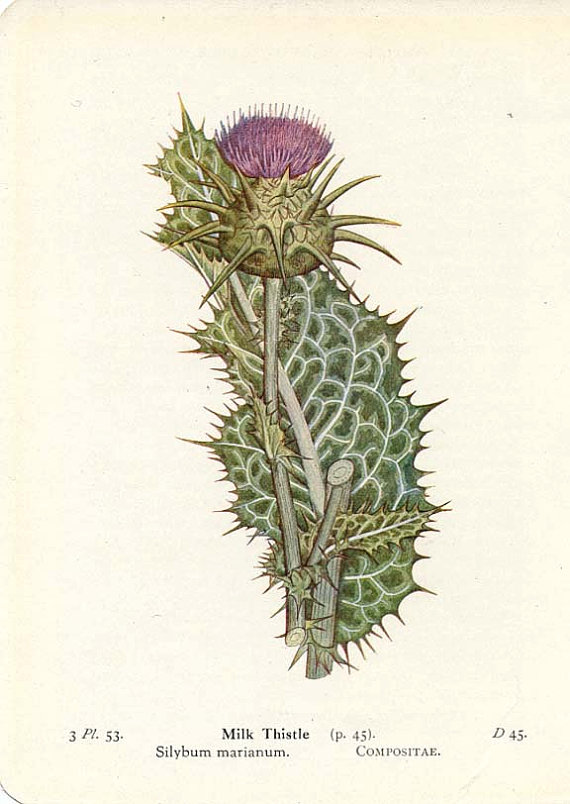Dr Clare Materia Medica
Introduction to the Dispensing of Dr Clare’s Blended Herbs
Special | A | B | C | D | E | F | G | H | I | J | K | L | M | N | O | P | Q | R | S | T | U | V | W | X | Y | Z | ALL
M |
|---|
Milk Thistle
Blessed Milk Thistle, Carduus Marianum, Holy Thistle, Silybum, Silymarin, St. Mary Thistle, St. Marys Thistle.
Scientific Name: Silybum marianum, synonym Carduus marianus. Family: Asteraceae/Compositae.
People Use This For: Milk thistle is used for liver disorders including toxic liver damage caused by chemicals, Amanita phalloides mushroom poisoning, jaundice, chronic inflammatory liver disease, hepatic cirrhosis, and chronic hepatitis. It is also used orally for loss of appetite, dyspepsia and gallbladder complaints, diabetes, hangover, and diseases of the spleen. Milk thistle is used orally for stimulating breast milk flow, and stimulating menstrual flow.
In foods, the milk thistle leaves and flowers are eaten as a vegetable and seeds are roasted for use as a coffee substitute.
Safety: No concerns regarding safety when used orally and appropriately. Milk thistle extracts standardized to contain 70% to 80% of the silymarin constituent seems to be safe when used for up to 41 months.38,39,40,41,42,43,44,45
Pregnancy and Lactation: Refer to a Medical Herbalist.
Effectiveness: POSSIBLY EFFECTIVE Diabetes. Taking the milk thistle constituent silymarin 200 mg three times daily for 4 months, in combination with conventional treatment, appears to significantly decrease fasting blood glucose, hemoglobin A1c (HbA1c), total cholesterol, low-density lipoprotein (LDL) cholesterol, and triglycerides compared to placebo in patients with type 2 diabetes.45 Other preliminary evidence suggests that silymarin 200 mg three times daily reduces insulin resistance in people with coexisting diabetes and alcoholic cirrhosis.46
Dyspepsia. A specific combination product containing milk thistle (Iberogast, Medical Futures, Inc) seems to improve symptoms of dyspepsia. The combination includes milk thistle plus peppermint leaf, German chamomile, caraway, licorice, clown's mustard plant, celandine, angelica, and lemon balm.47,48 A meta-analysis of studies using this combination product suggests that taking 1 mL orally three times daily over a period of 4 weeks significantly reduces severity of acid reflux, epigastric pain, cramping, nausea, and vomiting compared to placebo.49
INSUFFICIENT SCIENTIFIC EVIDENCE to COMMENT Alcohol-related liver disease.
Hepatitis B or Hepatitis C.
More evidence is needed to rate milk thistle for these uses.
Mechanism of Action: The applicable parts of milk thistle are the seed and above ground parts. The seed is most commonly used medicinally. Silymarin, the active constituent of the milk thistle seed, consists of four flavonolignans called silibinin (silybinin, silybin), isosilybinin, silichristin (silychristin), and silidianin. Silibinin makes up about 70% of silymarin.50,51 When ingested, silymarin undergoes enterohepatic recirculation and has higher concentrations in liver cells.
Adverse Reactions: Milk thistle is usually well-tolerated.52,51
Interactions with Herbs & Supplements: None known.
Interactions with Drugs: Tamoxifen (Nolvadex): (Used for breast cancer). Theoretical risk. Refer to a Medical Herbalist.
Interactions with Foods: None known.
Interactions with Lab Tests: None known.
Dosage/Administration: For diabetes, silymarin 200 mg three times daily has been used in combination with conventional treatment.46,45
References: MILK THISTLE 38. Szilard S, Szentgyorgyi D, Demeter I. Protective effect of Legalon in workers exposed to organic solvents. Acta Med Hung 1988;45:249-56. 39. Ferenci P, Dragosics B, Dittrich H, et al. Randomized controlled trial of silymarin treatment in patients with cirrhosis of the liver. J Hepatol 1989;9:105-13. 40. Salmi HA, Sarna S. Effect of silymarin on chemical, functional, and morphological alterations of the liver. A double-blind, controlled study. Scand J Gastroenterol 1982;17:517-21. 41. Bunout D, Hirsch S, Petermann M. [Controlled study of the effect of silymarin on alcoholic liver disease.] [Article in Spanish]. Rev Med Chil 1992;120:1370-5. 42. Trinchet JC, Coste T, Levy VG. [Treatment of alcoholic hepatitis with silymarin. A double-blind comparative study in 116 patients]. [Article in French]. Gastroenterol Clin Biol 1989;13:120-4. 43. Pares A, Planas R, Torres M, et al. Effects of silymarin in alcoholic patients with cirrhosis of the liver: results of a controlled, double-blind, randomized and multicenter trial. J Hepatol 1998;28:615-21. 44. Rambaldi A, Jacobs B, Iaquinto G, Gluud C. Milk thistle for alcoholic and/or hepatitis B or C virus liver diseases. Cochrane Database Syst Rev 2005;2:CD003620. 45. Huseini HF, Larijani B, Heshmat R, et al. The efficacy of Silybum marianum (L.) Gaertn. (silymarin) in the treatment of type II diabetes: a randomized, double-blind, placebo-controlled, clinical trial. Phytother Res 2006;20;1036-9. 46. Velussi M, Cernigoi AM, De Monte A, et al. Long-term (12 months) treatment with an anti-oxidant drug (silymarin) is effective on hyperinsulinemia, exogenous insulin need and malondialdehyde levels in cirrhotic diabetic patients. J Hepatol 1997;26:871-9. 47. Holtmann G, Madisch A, Juergen H, et al. A double-blind, randomized, placebo-controlled trial on the effects of an herbal preparation in patients with functional dyspepsia [Abstract]. Ann Mtg Digestive Disease Week 1999 May. 48. Madisch A, Holtmann G, Mayr G, et al. Treatment of functional dyspepsia with a herbal preparation. A double-blind, randomized, placebo-controlled, multicenter trial. Digestion 2004;69:45-52. 49. Melzer J, Rosch W, Reichling J, et al. Meta-analysis: phytotherapy of functional dyspepsia with the herbal drug preparation STW 5 (Iberogast). Aliment Pharmacol Ther 2004;20:1279-87. 50. Venkataramanan R, Ramachandran V, Komoroski BJ, et al. Milk thistle, a herbal supplement, decreases the activity of CYP3A4 and uridine diphosphoglucuronosyl transferase in human hepatocyte cultures. Drug Metab Dispos 2000;28:1270-3. 51. Boerth J, Strong KM. The clinical utility of milk thistle (Silybum marianum) in cirrhosis of the liver. J Herb Pharmacother 2002;2:11-7. 52. Anon. Milk thistle: Effects on liver disease and cirrhosis and clinical adverse effects. Summary, Evidence Report/Technology Assessment: Number 21, September 2000. Agency for Healthcare Research and Quality, Rockville, MD. Available at: http://www.ahrq.gov/clinic/epcsums/milktsum.htm 53. Huseini HF, Larijani B, Heshmat R, et al. The efficacy of Silybum marianum (L.) Gaertn. (silymarin) in the treatment of type II diabetes: a randomized, double-blind, placebo-controlled, clinical trial. Phytother Res 2006;20;1036-9. | |

 Also Known As:
Also Known As: